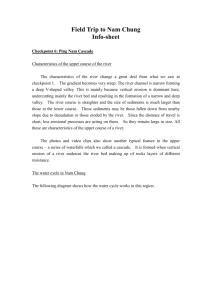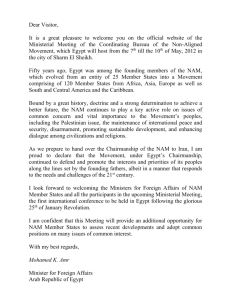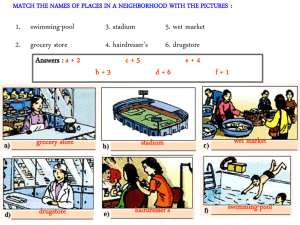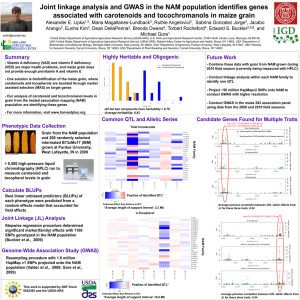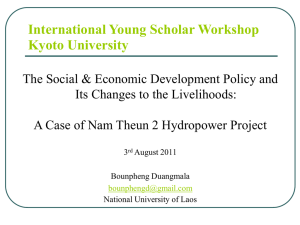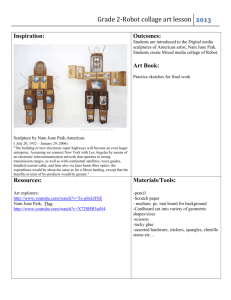water_resources_laos
advertisement
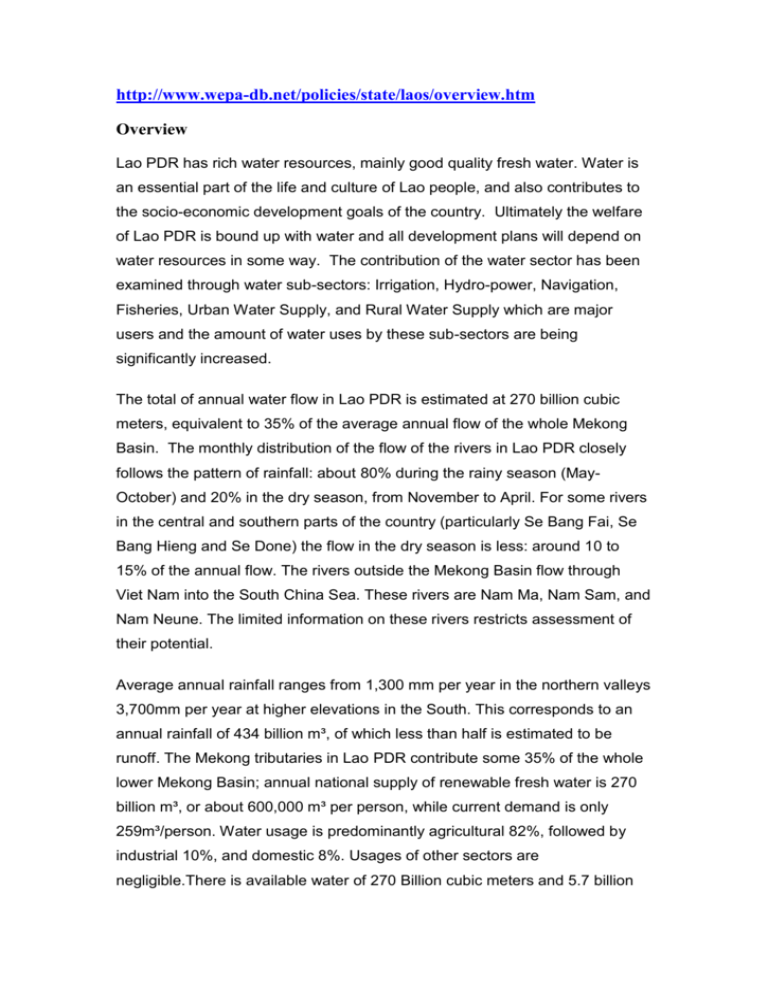
http://www.wepa-db.net/policies/state/laos/overview.htm Overview Lao PDR has rich water resources, mainly good quality fresh water. Water is an essential part of the life and culture of Lao people, and also contributes to the socio-economic development goals of the country. Ultimately the welfare of Lao PDR is bound up with water and all development plans will depend on water resources in some way. The contribution of the water sector has been examined through water sub-sectors: Irrigation, Hydro-power, Navigation, Fisheries, Urban Water Supply, and Rural Water Supply which are major users and the amount of water uses by these sub-sectors are being significantly increased. The total of annual water flow in Lao PDR is estimated at 270 billion cubic meters, equivalent to 35% of the average annual flow of the whole Mekong Basin. The monthly distribution of the flow of the rivers in Lao PDR closely follows the pattern of rainfall: about 80% during the rainy season (MayOctober) and 20% in the dry season, from November to April. For some rivers in the central and southern parts of the country (particularly Se Bang Fai, Se Bang Hieng and Se Done) the flow in the dry season is less: around 10 to 15% of the annual flow. The rivers outside the Mekong Basin flow through Viet Nam into the South China Sea. These rivers are Nam Ma, Nam Sam, and Nam Neune. The limited information on these rivers restricts assessment of their potential. Average annual rainfall ranges from 1,300 mm per year in the northern valleys 3,700mm per year at higher elevations in the South. This corresponds to an annual rainfall of 434 billion m³, of which less than half is estimated to be runoff. The Mekong tributaries in Lao PDR contribute some 35% of the whole lower Mekong Basin; annual national supply of renewable fresh water is 270 billion m³, or about 600,000 m³ per person, while current demand is only 259m³/person. Water usage is predominantly agricultural 82%, followed by industrial 10%, and domestic 8%. Usages of other sectors are negligible.There is available water of 270 Billion cubic meters and 5.7 billion has been used and the remaining amount of 264.3 Billion cubic meters flows in the natural rivers. Currently most of the water use occurs in the agricultural sector such as irrigation, fisheries, plantations and livestock watering. In addition the water is used for hydro-power; the country has the potential to produce 23,000 megawatts of electricity. Currently only 5% of that capacity has been exploited. The plenteous supply of water in Lao PDR, especially in the rainy season, provides good condition for water transport, industrial development and water supply. Sixty percent of urban population and 51 % of rural population has access to clean water. Currently there are some problems related to waste and polluted water in major urban areas from varied community use (residential density, hotels, hospitals and entertainments centers). In addition there is water pollution from agricultural and industrial sectors, including mineral exploitation. This is not a major problem now, but the problem could escalate. The degradation of natural water and water catchments from sedimentation, land erosion and drying out continues. River Water Main rivers of the Lao PDR dominantly consist of the first and second tributaries of the Mekong River. There are about 39 main tributaries in the Mekong river basin. Main rivers that have bigger catchmentarea of more than 5000 km², are the following 11 rivers: Nam Ou River Basin is located Northern region, Lao PDR; Nam Suang is located Northern region; Nam Khan is located Lang Prabang Province; Nam Ngum is located Northern-Central part; Nam Nhiep are located Phonesavan of Xiengkhoung province; Nam San is located Bolikhamxay province; Nam Theun/Kading is located Bolikhamxay Province; Sebangfay is located Khammouane Province; Sebanghieng is located Savannaket Plain; Sedone is located Southern part; and Sekong is located South-Eastern part of the country. Total watershed area of the main tributaries is estimated at about 183,000 km². On the other hand, only 2 main rivers, namely Nam Ma and Nam Ka rivers, are located outside of the Mekong river basin and expanded in the eastern area of Houaphan and Xieng Khuang provinces. Both drain through Viet Nam directly to the South China Sea. Total watershed area of both rivers is approximately 13,000 km² Generally physical and hydrological characteristics of the main rivers and their catchment areas are as follows: (1) Nam Ou River is the longest in the northern region of Lao PDR. It originates at Ban Lantoug Gnai Village near the Lao-China border and flow to the south. It has a total length of 390 km to the confluent point with the Mekong River. The total drainage area is 25,000 km² covering Phongsaly province, one third of Uodomxay province, and one haft of Loang Prabang province. The annual discharge is 12,276,964,800 m³ (2) Nam Suang River with a length of 150 km has a source near Ban Sopkok Village at 1,482 meters, flows in a south-west direction for about 50 km and then turns to the west and finally south-west ward to enter the Mekong River. The drainage area is 5,800 km² with 76.4% of the catchment classified as mountainous, and 22.9% as hilly. The annual discharge is 3,654,076,320 m³ (3) Nam Khane River with a length of 935 km has its origin near Phou Nam Pa at an altitude of 1,828 m. It flows down steep slope in the east-west direction to meet the Mekong River at Luang Prabang City at an altitude of 300 m. The drainage area is 6,100. The annual discharge is 29,454,624,000 m³. (4) Nam Ngum River with a length of 1,403 km and draining as area of 17,000 km² is the largest river of Xiengkhouang and Vientiane provinces and one of the major tributaries of Mekong in Lao PDR. The river source is located in the Plain of Jars about 1,000-1,100 m above mean sea level. After joining with Nam Lik, the Nam Ngum flows down into the Vientiane Plain for about 80 km in southerly direction to Tha Ngone, and then for another 80 km in an easterly direction to join the Mekong River at Pak Ngum District. The annual discharge is 23,021,280,000 m³. (5) Nam Nhiep River is a local name meaning quiet river. It originates from Phonesavanh Village in Xiengkhuang plateau with an altitude of 1,050 m above mean sea level, flows in a southerly direction to meet an important tributary called Nam Siam near Ban Xiangkhong Village and changes to the southeast direction to meet another tributary, Nam Chian. From this point to outlet near Paksan City, the river flows southerly for a distance of about 95 km. The length of Nam Nhiep is 156 km and catchment area is 4,270 km². The annual discharge is 5,885,248,320 m³. (6) Nam Sane River, locally known as steep river, originates from diamond of Phou Sam Soum Mountain with an altitude of 2,620 meters above mean sea level, flows to west-northwest through a group of villages around Ban Phouviang Village. It then flows down in the southwest to Ban Thathom Village, and continues to the south-southwest to meet the Mekong at Paksan City. The river is 120 km long with a catchment area of 2,230 km². The annual discharge is 4,271,235,840 m³. (7) Nam Theun/Kading River, where the upper part is in Khammouane province while the middle and the lower areas are in Bolikhamxay province in central Lao PDR, has several tributaries: as illustrated on map of stream flow, the upper reaches in the plateau consist of Nam One, Nam Noy, and Nam Theun that have total length of 138 km and drain as area of 2,800 km², the annual discharge is 7,027,166,880 m³. Nam Theun and its tributaries have many promising projects for flood control and hydropower. (8) Sebangfay River mountainous with some peaks higher than 1,500 meters. Flat land appears around Mahaxay District of Khammoune province, where an important tributary Nam Gong/ kathang is 38.5 km long, drains to Gnommalath District. Downstream of the Sebangfay Bridge, an area of up to 70,000 ha of potential agricultural land exists with wetlands, consisting of freshwater lakes, river, ponds, rice paddy and some freshwater marchers, of around 125 km². It is believed that the constant year round discharge of 13,623,552,000 m³ released from Nam Theun powerhouse will change the river morphology of the Sebangfay from Mahaxay to the confluence with the Mekong. (9) Sebanghieng River is situated in the southern part of Lao PDR, and adjoins the Sebangfay basin which extends immediately to the north. The two basins ranked as the largest basins of the country. The Sebanghieng originates in the Lao-Viet Nam borders at the elevations of 1,000 – 2,000 meters, flows westward with nine major tributaries, and then flows into the Mekong River at a point about 90 km downstream of Savannaket Province. It has a length of about 3,442 km. The total catchment area at the confluence with the Mekong is 21,516 km², and annual discharge is 15,673,392,000 m³. (10) Sedone River is a total length of 1,475 km, has its origin in the northeastern side of Bolaven Plateau near Thateng District at 800 m. The catchments area is 6,170 km², and annual discharge is 5,064,681,600 m³. (11) Sekong River, the source of the river is near the Lao-Viet Nam borders at an elevation of 1,800 meters. The length of the mainstream to Attapu is about 170 km. The total catchments area is 10,500 km², and annual discharge is 16,146,432,000 m³. Table 1: River Basin Areas and Annual Runoff of the Major River Basin in Lao PDR Basin No River Basin Name 1. Nam Ou 2. No Watershed area [sq.km.] Annual discharge [m³] Length of main stream [km] 19,700 12,276,964,800 390 Nam Suang 5,800 3,654,076,320 150 3. Nam Khane 6,100 29,454,624,000 250 4. Nam Ngum 16,500 23,021,280,000 1,403 5. Nam Nhiep 4,270 5,885,248,320 156 6. Nam Sane 2,230 4,271,235,840 120 7. Nam Theun/Cading 3,370 7,027,166,880 138 8. Nam Sebangfay 8,560 13,623,552,000 190 9. Nam Sebanghieng 19,400 15,673,392,000 370 10. Nam Sedone 6,170 5,064,681,600 1,574 11. Nam Sekong 10,500 16,146,432,000 170 Sources: Department of Hydrology and Methodology, 2004 In general, the water quality of rivers within the Lao PDR, and the Mekong is considered to be good, based on international standards. The level of oxygen is high and the nutrient concentration is low. Sediment is the primary pollutant source affecting rivers. Sedimentation loads in tributaries vary considerably from 41 tonnes/km²/year to 345 tonnes/km²/year. Tributaries and river reaches with high sedimentation are the Sebanghieng, Sedone, Nam Ou, and the upper and lower stretches of the Mekong (Water Sector Study, ADB, 1998). With the pressure of rapid demographic growth, socio-economic development and urbanization, however, the water quality is increasingly exposed to deterioration. In 1999, it was estimated that 35% of liquid effluent disposal to inland surface waters from all sources was treated, while the quantity was unknown. Since the developments in Lao PDR is at the initial stage, generally there were no yet any significant impacts from industrial and other developments to the water environment. Coupling with its abundance on water per capita, the water resources status of the country, both quality and quantity, is being in good conditions. Groundwater Groundwater is emerging as a large and generally untapped resource. However, there is very little monitoring of groundwater quality in Lao PDR, even though it is the main source of rural water supply. The study made by the Interim Mekong Committee (1986) observed that the country is divided into two geological areas: the Annamian Strata occupying most of northern and eastern part of the country and the Indosinian sediments mainly along the Mekong. There are three different aquifer systems: The Annamian aquifers occur randomly. These are local systems that discharge locally to the river or its tributaries. As local flow systems, they are not part of the regional flow system and will not carry pollution into the regional groundwater system. The potential water supply from groundwater in the northern part of the country is considerable in view of the high amount of recharge available. Water quality should be reasonably good and for the most part potable but will be iron rich. Yields up to 5 liters/sec can generally be anticipated. The Indosinian group of aquifers, which have regional flow, includes rock of the Indonisian Moyennes and Superieures and is relatively young. They are mostly freshwater sediments, although there are horizons of brackish water, and one major zone of saline water. Yields of 12-24 liters/sec can be developed. The alluvial aquifers associated with the sedimentary deposits of the Mekong River are not rated highly as aquifers. Limestone in the Central Lao PDR is strictly Annamian in age, but its location places it logically in the Indosinian flow system. It has been described as having enormous groundwater resources. To date the only regional assessment of groundwater potential is the on-going study of groundwater in the Provinces of Champassack and Saravane funded by JICA. There are, however, studies and use of groundwater at specific locations for urban water supply purposes, and several hundreds of wells have been drilled throughout the country mainly for rural supply but also for a few cottage and small-scale industries. Information relating to drilled wells for rural water supply generally includes a location sketch, depth of the wells, type of pump and ground water level. Geological logging and yields tests are only occasionally undertaken. The information of drilled wells for rural water supply is kept at the offices of the Provincial Rural Water Supply Center. In most cases, the depth of the rural water supply wells in lowland areas varies from 30 to 45 meters and the yields varies from about 1 liter/sec to less than 5 liters/sec. The groundwater is and will probably remain the main source of potential rural and small town water supply, especially in lowland areas located far from the surface water sources such as the southern and western parts of Champassack Province, the hinterlands of the Senbangfay, Sebanghieng and Sedone valley. Anecdotal evidence suggests that poor sanitation and sewerage facilitiesare contributing towards the contamination of surface and groundwater.

